A new family of receptor tyrosine kinases with a venus flytrap binding domain in insects and other invertebrates activated by aminoacids
- PMID: 19461966
- PMCID: PMC2680970
- DOI: 10.1371/journal.pone.0005651
A new family of receptor tyrosine kinases with a venus flytrap binding domain in insects and other invertebrates activated by aminoacids
Abstract
Background: Tyrosine kinase receptors (RTKs) comprise a large family of membrane receptors that regulate various cellular processes in cell biology of diverse organisms. We previously described an atypical RTK in the platyhelminth parasite Schistosoma mansoni, composed of an extracellular Venus flytrap module (VFT) linked through a single transmembrane domain to an intracellular tyrosine kinase domain similar to that of the insulin receptor.
Methods and findings: Here we show that this receptor is a member of a new family of RTKs found in invertebrates, and particularly in insects. Sixteen new members of this family, named Venus Kinase Receptor (VKR), were identified in many insects. Structural and phylogenetic studies performed on VFT and TK domains showed that VKR sequences formed monophyletic groups, the VFT group being close to that of GABA(B) receptors and the TK one being close to that of insulin receptors. We show that a recombinant VKR is able to autophosphorylate on tyrosine residues, and report that it can be activated by L-arginine. This is in agreement with the high degree of conservation of the alpha amino acid binding residues found in many amino acid binding VFTs. The presence of high levels of vkr transcripts in larval forms and in female gonads indicates a putative function of VKR in reproduction and/or development.
Conclusion: The identification of RTKs specific for parasites and insect vectors raises new perspectives for the control of human parasitic and infectious diseases.
Conflict of interest statement
Figures
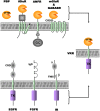


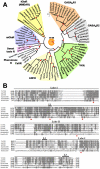
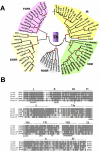
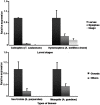
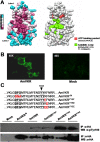
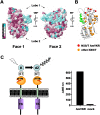

References
-
- Yarden Y, Ullrich A. Growth factor receptor tyrosine kinases. Annu Rev Biochem. 1988;57:443–478. - PubMed
-
- Blume-Jensen P, Hunter T. Oncogenic kinase signalling. Nature. 2001;411:355–365. - PubMed
-
- Miller MA, Steele RE. Lemon encodes an unusual receptor protein-tyrosine kinase expressed during gametogenesis in Hydra. Dev Biol. 2000;224:286–298. - PubMed
-
- Reidling JC, Miller MA, Steele RE. Sweet Tooth, a novel receptor protein-tyrosine kinase with C-type lectin-like extracellular domains. J Biol Chem. 2000;275:10323–10330. - PubMed
Publication types
MeSH terms
Substances
LinkOut - more resources
Full Text Sources

